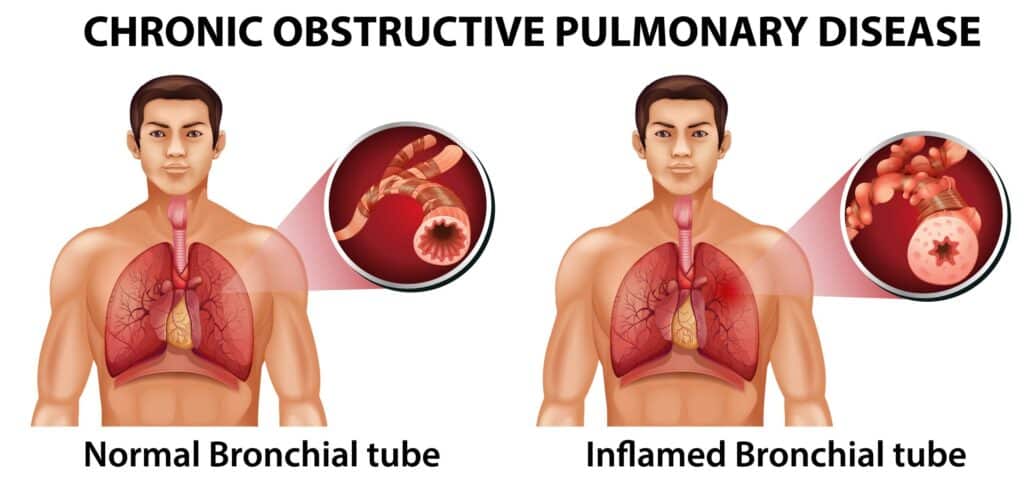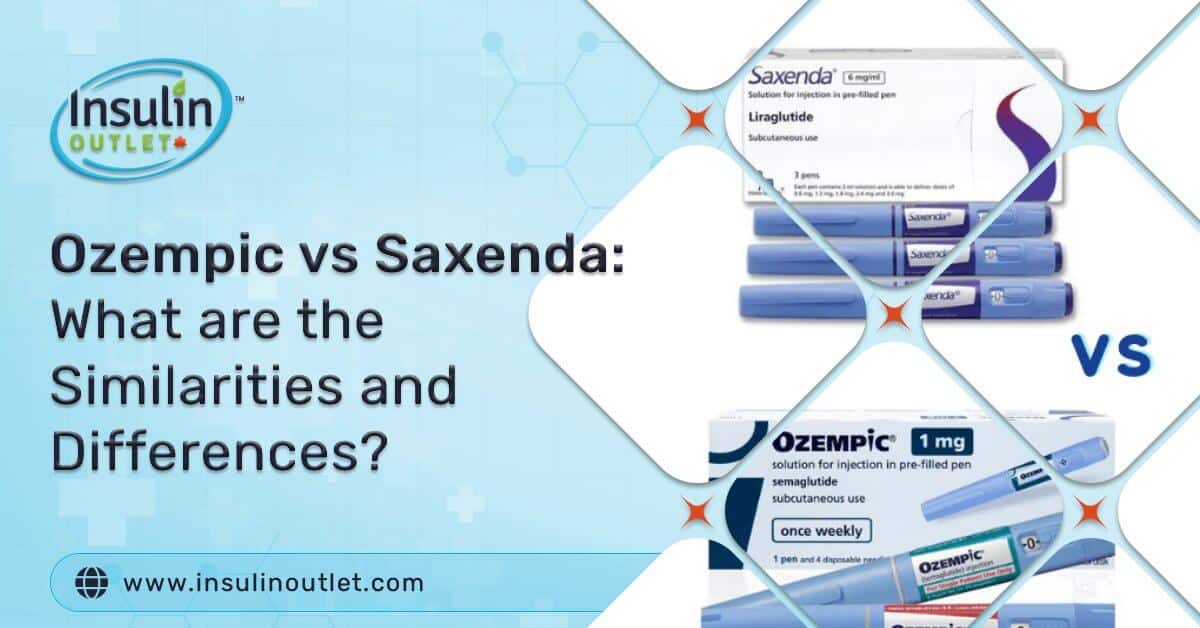
The CDC ranks chronic obstructive pulmonary disease (COPD) fourth in the top 10 causes of death. In the United States of America, approximately 15 million people suffer from COPD. Even more, people likely suffer from COPD because many people are unaware that they have it. The following groups have been known to be diagnosed with COPD:
- Women
- People 65 to 74 years old
- American Indians/Alaska Natives and multiracial non-Hispanics
- People who are unemployed, retired, or not able to work
- People without a high school education
- People who are divorced, widowed, or separated
- Current or former smokers
- People with a history of asthma
Fortunately, COPD is treatable. But even with treatment, COPD needs to be constantly monitored to assure there are no side effects or symptoms that can cause the condition to worsen.
Table Of Contents
ToggleWhat is COPD?
COPD is a disorder that persistently obstructs bronchial airflow, which leads to breathing problems. COPD can be complicated by chronic bronchitis and emphysema. Both cause chronic obstruction of air flowing through the airways and in and out of the lungs. The obstruction is usually permanent and can become worse over time.
An early diagnosis and treatment of COPD can slow its progression. For many people, treatment can include: quit smoking, pulmonary rehabilitation, supplemental oxygen, and medication.
The most common form of medication for the treatment of COPD is Trelegy. While Trelegy may be a great way of relieving symptoms of COPD, users must also understand the potential side effects and conditions that can come from persistent use of the medication if treatment is not monitored.

What is Trelegy?
Trelegy is a prescription medication taken once a day to treat COPD and other conditions that can lead to breathing problems like chronic bronchitis and asthma.
3-in-1 Trelegy or Trelegy 100/62.5/25 mcg is the only 3-in-1-once-daily medicine approved by the FDA. The three long-acting COPD medicines in one inhaler, taken daily, help prevent symptoms from occurring.
What Should Your Doctor Know Before Prescribing Trelegy?
Before having any medication prescribed, your doctor should be informed of current medications. Before taking this medication, make sure your healthcare provider is aware of your medical conditions and your current medications. They should also be mindful of over-the-counter medicines, vitamins, and supplements.
Your doctor should especially know if you have allergies to milk proteins if you have heart problems, high blood pressure, seizures, thyroid problems, diabetes, liver problems, osteoporosis, or issues with your immune system. They should also know if you have prostate or bladder problems, a viral, bacterial, parasitic, or fungal infection, or if you’ve been exposed to chickenpox or measles. Please inform your medical expert if you are pregnant or planning to get pregnant, breastfeeding, or have problems with your eyes, like glaucoma or changes in your vision. Trelegy could make one or any of these conditions worse or cause serious side effects.
Trelegy and certain medicines may interact with each other. When this happens, it can cause serious side effects. Other medications to avoid interacting with Trelegy are anticholinergics, atropine, other long-acting beta2-adrenergic agonists, antifungal or anti-HIV medicines.
It is always essential to know the medications you currently take. One way to do this is to keep a list of all of your medications, especially if it’s quite a bit. The list is a convenient way of keeping your healthcare provider informed at all times, especially in emergencies.
Be sure to let your healthcare professional know of any and all insulin you are taking. This includes insulin aspart, insulin isophane, insulin degludec and many more. If needed, be sure to bring along or take a picture of your insulin vials, pens or cartridges to show exactly what you are taking.
Would I Need More Trelegy Than the Prescribed Amount?
If you’ve been following your doctor’s orders and taking your medication as prescribed without any breathing relief, you may feel a need to take more than the specified amount. That is always a bad idea.
Never take more of any prescription than recommended by your doctor. Always talk to your healthcare professional, physician, or nurse if you feel the prescribed dosage or the medication is not working before making any changes. Your doctor may see a need to increase your dosage or change medications altogether. Not following a prescribed dosage could run the risk of side effects of the medicine.
When Should I Stop Taking Trelegy?
Unless your prescription specifies taking the medication for a prescribed number of days, the drug is intended to be taken daily. Never stop taking Trelegy, even if you feel like the systems no longer exist, unless your healthcare professional instructs you to do so. There is the risk of your symptoms coming back or getting worse if the medication is not taken daily, as prescribed.
When Should Trelegy Not Be Used?
Trelegy should not be used to treat sudden, severe breathing problems or asthma. Trelegy should not be used if you have a severe allergy to milk proteins. Trelegy should not be used if you are allergic to fluticasone furoate, umeclidinium, vilanterol, or any of the ingredients found in Trelegy. Using Trelegy under any of these conditions could cause serious side effects.
Trelegy should not be used by children 18 years old or younger. Trelegy should not be administered more often than prescribed by your doctor. Always contact your doctor if your breathing problems get worse while taking Trelegy.
The risks of side effects are common in most medications. The risk of side effects with the use of any drug is always higher if the medication is not taken as prescribed.
Common Side Effects of Trelegy
Taking Trelegy as prescribed by your doctor is critically important. It is also essential to inform your doctor of any known allergies or medical conditions before taking Trelegy. Doing so can prevent serious side effects. Some of the severe side effects of Trelegy include:
- Thrush: Thrush is a fungal infection in your mouth or throat. If you use Trelegy, you may want to rinse your mouth without swallowing to reduce the thrush risk.
- Pneumonia: People with COPD are at high risk of pneumonia. Trelegy can increase that risk. Call your doctor if you notice mucus that changes in color or amount or if you experience fever or chills, Also be alert for if your cough increased or breathing problems increase.
- Weak immune system: A weakened immune system increases your chances of infection.
- Reduced adrenal function: A reduced adrenal function can happen when you no longer take oral corticosteroids and begin taking inhaled corticosteroids.
- Sudden problems with breathing: If you notice sudden breathing problems immediately after inhaling Trelegy, stop taking Trelegy and call your doctor right away.

- Severe allergic reactions: A rash, hives, swelling of your face, mouth, and tongue, and breathing problems could be an indication of allergic reactions. Call your healthcare professional right away or seek emergency care should you get any of those symptoms while taking Trelegy.
- Heart issues: Side effects of Trelegy that affect the heart include increased blood pressure, a fast or irregular heartbeat, awareness of heartbeat, or chest pain.
- Effects on the nervous system: Side effects of Trelegy that affect the nervous system include tremors and nervousness.
- Weakness of bones: Bone thinning or weakness of the bones, also known as osteoporosis, can arise as a side effect from Trelegy.
- Eye problems: Trelegy can cause side effects, like glaucoma, increased pressure in your eye, cataracts, blurred vision, worsening of narrow-angle glaucoma, or other eye issues. Regular eye exams are essential while using Trelegy. Acute narrow-angle glaucoma can cause permanent loss of sight if it goes untreated. Some of the symptoms of acute narrow-angle glaucoma include: Eye pain or discomfort, nausea or vomiting, blurred vision, seeing halos or bright colors around lights or redness of the eyes.
- Urinary Issues: It is possible to have new or worse urinary retention while using Trelegy. Symptoms include difficult, painful, or frequent urination and urination in a weak stream or drips. Should this happen, stop taking Trelegy immediately and call your doctor right away.
- Changes in lab work: Changes in your laboratory blood values, like levels of blood sugar or hyperglycemia, and low levels of potassium or hypokalemia, are also possible when taking Trelegy.
- Slowed growth in youth: Trelegy is not for use for children 18 years old or younger. If accepted, Trelegy could cause a slow down of their development.
While side effects can occur, some side effects that do not require medical attention include back pain, change in taste, cough, diarrhea, headache, nervousness, sore throat, and tremors. Report these symptoms to your healthcare professional if they continue or become a problem.
Final Words
Trelegy is only meant to be taken once a day. While on Trelegy, visit your doctor regularly for checkups. Alert your doctor if any symptoms related to side effects should occur. Call your doctor immediately should more severe symptoms exist. Trelegy is not an answer for acute asthma or a COPD attack. Trelegy is not a rescue inhaler and should not be used as one.
With any medication, it’s essential to know what it’s treating and how to use it. When used correctly and with a well-informed history of medical conditions, Trelegy can be the relief that people with COPD need to increase their quality of life.
Trelegy Ellipta
$155.27 – $184.95Share:












